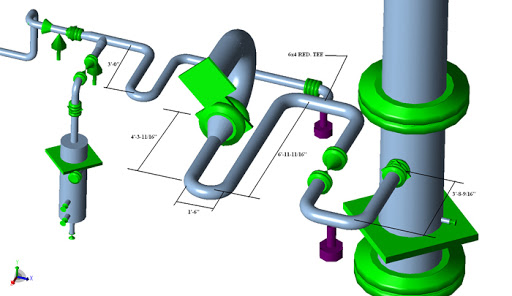CEASER II

About Course
Course Description:
” The world’s most widely used pipe flexibility and stress analysis software ”
CAESER II (Computer Aided Engineering Stress Analyzing Report) is a complete solution that enables quick and accurate analysis of piping systems subjected to a wide variety of loads, considering, weight, pressure, thermal, seismic and static and dynamic conditions based on user defined variables.
It is also the Pipe & Structural Stress Analysis standard against which all others are measured and compared. It is a PC- based pipe & structural stress analysis engineering software used in the mechanical design and analysis of piping and structural systems.
Course Highlights
By the end of this training course, participants will be able to know how to:
- Use the Caesar II software very well
- How to make a 3D modeling Piping
- How to add Anchors, Flange pairs, bends, supports, valves etc.
- How to make and interpret a Pipe Stress Analysis
- Differentiate between primary and secondary stress
- Analyze design code requirements
- Identify ways to resolve overstress due to thermal expansion
- Work upon load case combinations and design system for Sustain, Expansion & Occasional Loading
- Prepare to stress Critical line list
- Modeling and analysis of a transmission line, jacketed riser, hydrodynamic loading, and more
- Work upon different models including Storage Tank-pump system modeling, Column-heat exchanger model, Pipe Rack CAESAR II Model, Equipment modeling
Course Benefits
- Enhanced Precision
- Expertise in Caesar II is highly sought after in industries such as oil and gas, petrochemicals, power generation, and chemical processing, where piping systems are critical.
- Mastering Caesar II improves your ability to perform complex piping stress analysis, making you a valuable asset to engineering teams.
- The software enhances your ability to identify and mitigate potential issues in piping systems, improving overall system reliability.
- Specialized skills in Caesar II can command higher salaries due to the technical expertise required.
- Expertise in a niche area like piping stress analysis ensures a steady demand for your skills, contributing to job stability.
- Certifications and proven experience with Caesar II enhance your professional credibility and reputation in the industry.
- Piping engineers with Caesar II skills are often required for international projects, providing opportunities to work abroad.
- Participation in global projects and professional communities enhances your network and exposure to international best practices.
- Delivering high-quality, reliable piping solutions enhances client satisfaction and can lead to repeat business and referrals.
- Ensuring compliance with industry standards and regulations protects your organization from legal and financial penalties.
- In fact, using Caesar II keeps you at the forefront of technological advancements in piping engineering, allowing you to implement innovative solutions.
- In a nutshell, learning Caesar II offers significant career advantages, including increased demand, higher earning potential, global opportunities, and professional recognition. These perks collectively contribute to a successful and fulfilling career in piping engineering and related fields.
